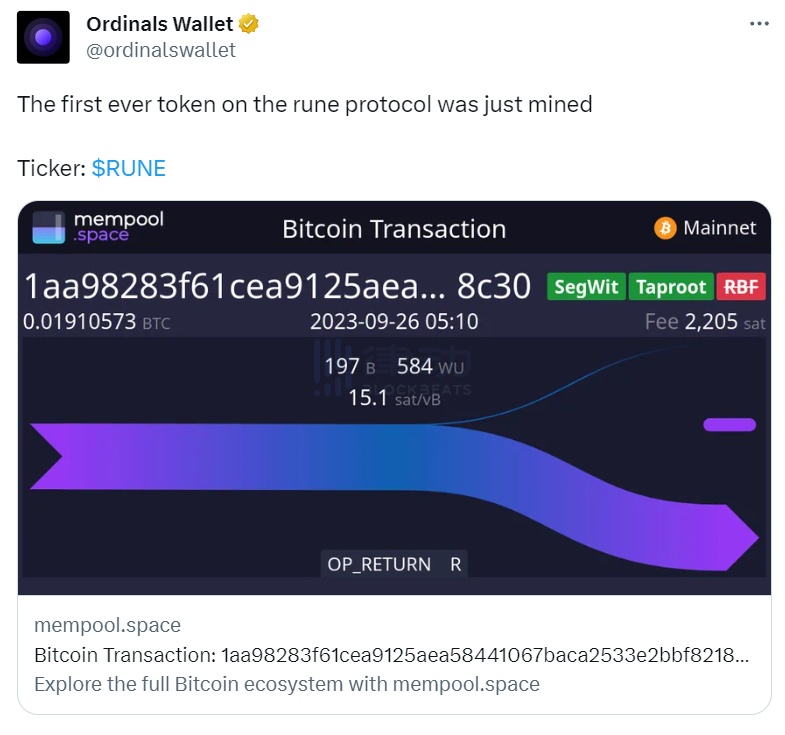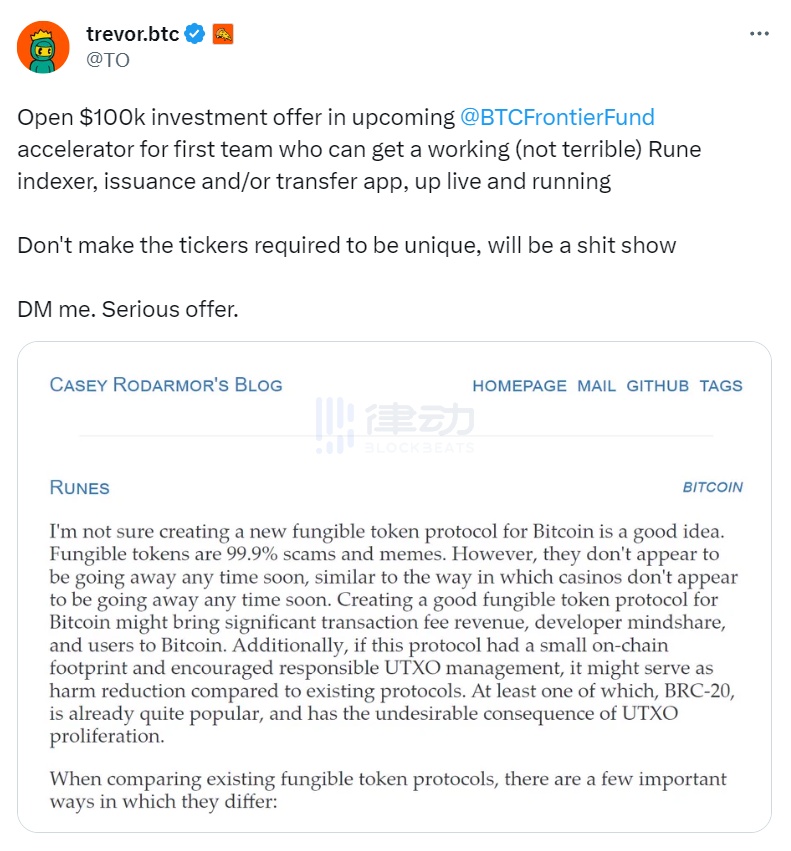BRC-20 speculation is prevalent, will the new FT protocol Rune released by Ordinals founder bring a new trend?
Will the release of Rune, a new FT protocol by the founder of Ordinals, bring a new trend in BRC-20 speculation?Author: Cookie
Today, Casey Rodarmor, the founder of the Bitcoin NFT protocol Ordinals, proposed a new Bitcoin FT protocol design concept called “Rune”. This protocol is also known as the “Rune” protocol.
What are the differences between this protocol and FT protocols such as BRC-20 and Taro/RGB on the Lightning Network? Why did Casey suddenly propose the idea of the “Rune” protocol? What progress has been made in less than a day since the idea was introduced?
BlockBeats will provide you with a detailed overview of all aspects of the “Rune” protocol.
- LianGuai Daily | HTX hot wallet was stolen about 8 million US dollars; US SEC opposes Celsius distributing tokens to customers through Coinbase
- Analyst Bitcoin ETF may be approved in early 2024.
- Bitcoin price faces risks? The golden cross of the US dollar strength index has been confirmed.
The Design Philosophy of the “Rune” Protocol
Casey Rodarmor summarized the biggest feature of the “Rune” protocol in one sentence – a simple, UTXO-based FT protocol that provides a good user experience for Bitcoin users.
Casey believes that if the on-chain “footprint” of this protocol is small and it promotes trusted UTXO management, it may reduce the “harm” compared to existing Bitcoin FT protocols. At least, the popularity of BRC-20 has already created a large number of “garbage” UTXOs.
Casey compared the “Rune” protocol with other existing Bitcoin FT protocols in the following 4 aspects:
- Complexity: How complex is the protocol? Is it easy to implement? Is it easy to be widely adopted?
- User Experience: Are there any implementation details that may have a negative impact on the user experience? In particular, protocols that rely on off-chain data have a small on-chain “footprint” but introduce significant complexity. And users either have to run their own servers or find existing servers to interact with.
- State Model: UTXO-based protocols are more natural for Bitcoin and promote UTXO set minimization by avoiding the creation of “garbage” UTXOs.
- Native Token: Protocols that require native tokens for protocol operations are cumbersome, extractive, and are unlikely to be widely adopted.
The comparison results are as follows:
- BRC-20: Not UTXO-based and quite complex, as it requires the use of the Ordinals protocol for certain operations.
- RGB: Very complex, relies on off-chain data, and has been developed for a long time without widespread adoption.
- CounterLianGuairty: Certain operations require the use of native tokens instead of being UTXO-based.
- Omni Layer: Certain operations require the use of native tokens instead of being UTXO-based.
- Taproot Assets (Taro): Somewhat complex, relies on off-chain data.
So how will the “Rune” protocol be implemented to address the pain points mentioned above?
Implementation of the “Rune” Protocol
Overview
The balance of “Rune” tokens is directly included in UTXOs, and UTXOs can contain any number of “Rune” tokens.
If a transaction contains an output, and the script pubkey of that output contains an OP_RETURN followed by a data output representing the uppercase letter “R”, then the transaction contains a protocol message. The protocol message is everything after the first data output.
If invalid protocol messages and “Rune” tokens are inserted into a transaction, the “Rune” tokens will be burned. This will allow the “Rune” protocol to be upgraded in the future, avoiding allocation errors in previously created/allocated “Rune” tokens in older protocol versions.
Integers are encoded as prefix variables, where the starting part of the variable determines the byte length of the “Rune” token.
Transfer of “Rune” Tokens
The first data output in the protocol message is decoded as an integer sequence, which will include three types of information: “ID,” “OUTPUT,” and “AMOUNT.” If the decoded integer count is not a multiple of three, the protocol message will be considered invalid.
- ID: Specifies which “Rune” token the transfer is for. Each “Rune” token is assigned an ID when created, starting from 1, with lower ID values assigned to earlier created “Rune” tokens.
- OUTPUT: Determines which output the allocation is for.
- AMOUNT: The amount of “Rune” tokens to be transferred. If the AMOUNT is 0, it represents the total remaining balance of the account in “Rune” tokens.
After performing all operations included in the integer sequence, any remaining “Rune” tokens that do not require operations are allocated to the first non-OP_RETURN output. Additionally, if “Rune” tokens are allocated to the OP_RETURN output containing the protocol message, the “Rune” tokens may be burned.
Creation of “Rune” Tokens
If there is a second data output following the protocol message, the transaction is a “Rune” token creation transaction. This part of the data output is decoded as two integers: “SYMBOL” and “DECIMALS.” Any additional integers are considered invalid.
- SYMBOL: Equivalent to the Ticker of BRC-20 (i.e., token name), supporting a maximum of 26 characters with only A-Z allowed.
- DECIMALS: Determines the precision of the “Rune” token, i.e., the number of decimal places it supports.
If the “SYMBOL” has not been used before, the “Rune” token will be assigned an ID value. The first created “Rune” token has an ID value of 1, and the names BITCOIN, BTC, and XBT are prohibited. If the “SYMBOL” has already been used, the creation will be invalid. In other words, the “Rune” protocol still does not support the creation of tokens with the same name.
Display of Bitcoin Balances in UTXOs
In a UTXO, the balance of Bitcoin will be displayed as BITCOIN, BTC, or XBT, or in the form of an ID value of 0.
Why did Casey suddenly propose the concept of the “Rune” protocol?
In the official manual of the Ordinals protocol, we can see that Casey’s vision for the Ordinals protocol was a protocol for creating “digital artifacts” or “NFTs” using Bitcoin. However, with the development of the Ordinals protocol, the number of inscriptions related to BRC-20 has accounted for over 85% of the total inscriptions.
Casey has been dissatisfied with BRC-20 for a long time, especially his recent controversial tweets, which reflect his negative attitude towards BRC-20:

The Christmas gift I want the most is for speculators to discover Taproot Assets (Taro) so that they can stop minting BRC-20 Tokens

Can't we engrave a "transfer inscription" to lock the balances of BRC-20 Token holders, so that they have to send the transfer inscription to themselves to unlock the balances?
In Casey’s view, the “art gallery” he created has become a paradise for speculators, which makes him very uncomfortable. Not only has his “art gallery” turned into a “casino”, but Casey also has a negative attitude towards FT itself:

In this blog post proposing the Rune protocol, Casey concludes at the end of the article, “The world of FT is almost an irreparable abyss full of deception and greed.”
The proposal of the Rune protocol can be regarded as Casey’s “radical treatment” for the Ordinals protocol. Although he is the founder of the protocol, he cannot unilaterally eliminate what he considers a “tumor” parasitic on the Ordinals protocol in the Web3 world. So he came up with this idea – this is the “art gallery”, if you want to continue Degen, I have an idea, let’s go to the “casino” Degen OK or not OK?
Having said that, Casey only proposed the Rune protocol as an idea about the Bitcoin FT protocol, and he himself has no intention of implementing it. However, Casey’s influence is there, and we can already see how excited players are in less than a day.
In less than a day, what developments has the Rune protocol made?
The Bitcoin NFT trading market Ordinals Wallet announced the deployment of the first Token $RUNE of the Rune protocol at 3:00 PM.

However, someone pointed out in the comments of the tweet that this seems to be an invalid deployment…

In addition, @TO launched a public bounty, offering a reward of $100,000 to the first team to create a Rune protocol indexer.

Here, it is important to remind everyone that there is no conclusion as to whether the deployment of $RUNE is valid, because this protocol is currently only Casey’s idea and there are no relevant standards or code drafts. Be careful of all kinds of scams!
Conclusion
Casey’s idea is more of a helplessness to everyone, saying – I have a better way than BRC-20, would you consider going back to the original development direction of Ordinals?
So will BRC-20 “die”? I don’t think we need to be too pessimistic. Over the past few months, BRC-20 has attracted a large number of teams for development, and these teams will not give up just because of Casey’s idea. Moreover, BRC-20 is also evolving dynamically. Can it be combined with the Lightning Network to solve some of the current pain points? These are all things to look forward to.
Finally, Casey’s soul-searching question –
99.9% of FTs are memes and scams. I’m not sure if creating a new FT protocol for Bitcoin is really a good idea?
We will continue to update Blocking; if you have any questions or suggestions, please contact us!
Was this article helpful?
93 out of 132 found this helpful
Related articles
- Web3 enters ‘late autumn’ ahead of schedule, how should industry builders respond?
- Calaxy Co-founder 3 Facts You Need to Know Before the Next Bull Market
- An overview of the top 12 Bitcoin ETFs worldwide ProShares takes the lead, holding over 35,000 Bitcoins.
- Wu said Zhou’s selection The Federal Reserve did not raise interest rates, Mt Gox repayment date postponed, Tether crazy purchases of GPUs, and the top 10 news (0916-0922).
- Bitwise has withdrawn its application for a Bitcoin and Ethereum market-cap-weighted ETF.
- First Market Observation A Brief Discussion on Derivatives, Ton, Games, and ZK New Trends After Token2049
- After Token2049 Discussing Derivatives, Ton Ecology, Games, and ZK in the Primary Market Trend



